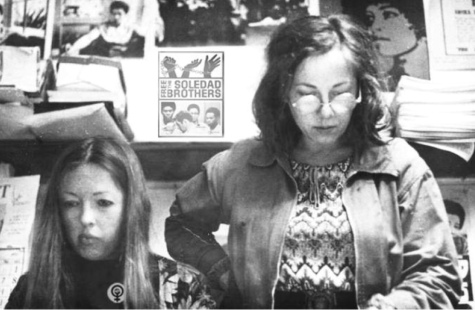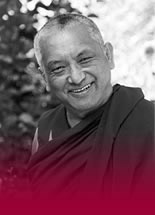Travel Blogs
9 August, 2016 | Australia
I flew from Jakarta to Perth June 29 and was met by Julia Kelly, who runs the Hayagriva Study Group in Albany, in the southwest corner of the state, and we drove the five hours there. I was there for the first few days of July.

Left: the beach at Albany. Right: Here’s the ground I covered in Australia this year, since April – not in the direction that map shows. Those 9,577 kilometers come to about 5,950 miles.
Then it was to Perth for a couple of weeks, staying at Hayagriva Centre, with the next weekend in Bunbury and the following one in Broome, way up north.
The state of WA covers nearly a third of the entire continent, as the map shows, but it has not even 3 million people living there. Australia’s total is some 24 million. Even by Australia’s standards, that’s a pretty slim population.
According to Peter Baskerville on quora.com, the World Bank’s research on population density shows that of all the countries on this earth Australia, with 3 people per square kilometer of land, is the second lowest, after Mongolia, which has 2.
The major reason, he says, for the low population density is explained in the following maps (courtesy of quora.com). The distribution of rainfall brings the following type of vegetation and geography –

Which causes the population distribution to look something like this:

And here’s how Australia size-wise compares with the United States, which has 324.5 million inhabitants.

Forty-five percent of Australia is desert – if it started in San Francisco it would reach all the way to Chicago.
Another interesting piece of information is that 66 percent of Australians live in the eight capital cities, with Sydney and Melbourne with 5 million and 4.5 million respectively, and Darwin, the capital of the Northern Territory, with 145,000.
As for the population of Buddhists, it would seem that there are many more Buddhists per head of population than in the United States. We did research for Mandala in 1996, when His Holiness visited Australia for a couple of months, that showed this fact. According to Wikipedia there are some 420,000 in Australia and 1.2 million in the USA.
From Perth I flew north to Broome: the red earth up there is extraordinary, it never fails to impress me. The group have been given a name by Lama Zopa Rinpoche – Gyalwa Ensapa – and it’s run by Sandy and Valerie. For years it was Lesley Baxter who kept the group going, who started it, in fact.
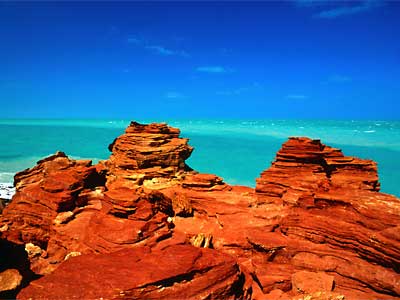
The colors in Broome are really just like this.
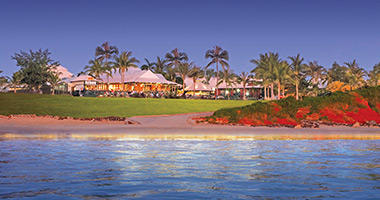
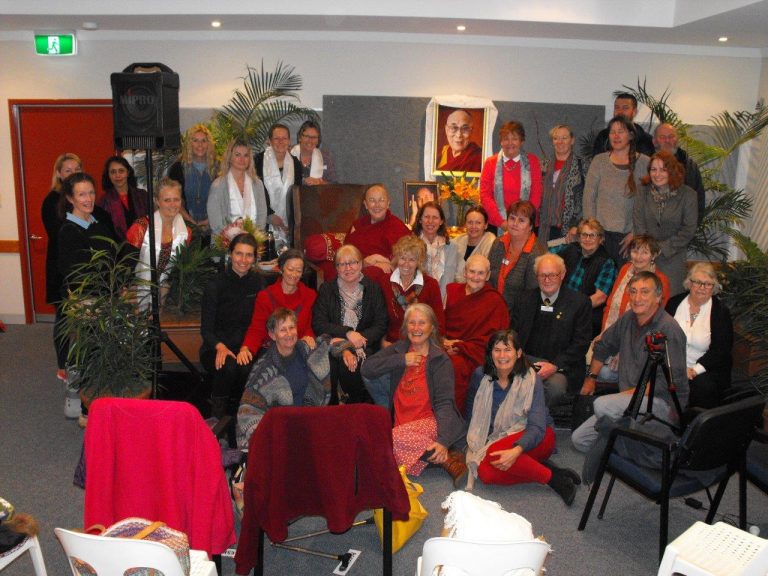
Our group at Hayagriva Study Group in Albany. And, below, with my old friend Owen Cole in Perth.
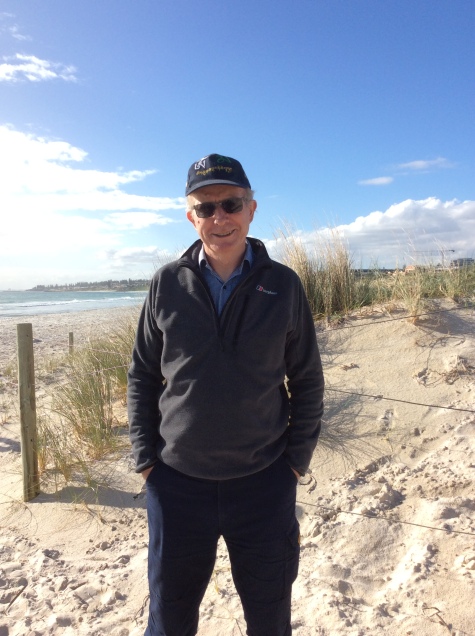 In Perth I hung out with Owen Cole, who over the years has run several FPMT projects and has now retired from his job as a journalist.
In Perth I hung out with Owen Cole, who over the years has run several FPMT projects and has now retired from his job as a journalist.
I always remember one piece of advice he told me that Lama Yeshe gave: “It’s better to eat molten iron than to eat tsog offerings with attachment!”
I won’t forget that in a hurry.
-----
After WA I spent two weeks in Adelaide, at Buddha House. They’ve bought a new place and are working hard getting it ready for a December move.
One evening I did a quick roundtrip to Sydney for an interfaith talk at Newington, a boys’ college. Interesting night; it was chaired by the ABC Radio National reporter John Cleary.

At Newington College, Sydney, above, from left, after the two schoolboys, a Jesuit, the Muslim Susan Carland (with, inset, her husband the Melbourne journalist Waleed Aly), a Jewish rabbi, John Cleary, me, and an Anglican priest. Below: Here we are at Buddha House in Adelaide; and left, with a little friend.
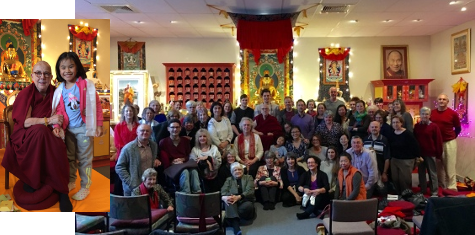
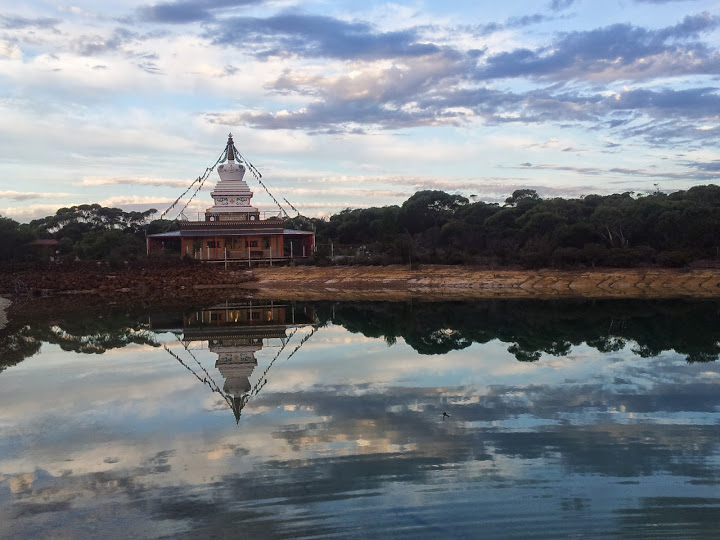
The thirty-foot enlightenment stupa at Kangaroo Island’s Detong Ling.
Buddha House’s resident teacher, Australian monk Ven. Dondrub, is in long retreat on Kangaroo Island’s retreat center, Detong Ling.
As I mentioned in postcard 14, I have a soft spot for Adelaide: it’s were I ran away to, from Melbourne, at the age of 19. And it’s where I first gave up going to Mass and opening my mind to other ways of seeing the world. It was “Goodbye God, hello boys,” basically. Being a good Catholic contradicted certain behavior so I decide to make a clean break and go from there. I don’t recall having any guilt about it.
We run to guilt pretty easily. It seems to me, if we analyze it carefully, it’s very linked to our internalized ideas about what we’re supposed to be and act like. And that’s linked to the deepest levels of attachment – so primordial, so instinctive, that we rarely unpack it.
But we must. That’s Buddha’s approach: our thoughts, our deep assumptions are why we suffer so we need to be able to hear them and question them. But we take so much of what goes on in our heads for granted! We never question. As Lama Zopa Rinpcohe says – and it sounds pretty shocking – “the vast majority of people on this planet have no idea that what goes on in their mind plays any role at all in their lives.”
I mean, we know we feel guilt and attachment and anger and the rest, but we take them for granted and, mostly, we look to the outside for the blame for why we have them. So what is this primordial level of attachment? We don’t really learn about it in the teachings until the bodhisattva path when we hear about “the eight worldly dharmas.” Basically, they’re pervasive levels of attachment. There are four sets of pairs, and the last pair is the one I’m referring to in relation to guilt.
They call it attachment to reputation, and basically it’s our craving to be seen in a good light – and the rest of the time craving to be free from being seen in a bad light. Since we’re born we’ve learned what to say and do in order to get the best response from everyone out there. It’s as if, with this attachment, we have zero sense of our own self so must constantly look out there for feedback, which we assume means we must have said and done the “right” thing, the thing that gets people to approve of us. This craving underpins most of decisions – what a nightmare!
Guilt, then, seems to be our internalized mother and father and God and the various authorities out there that we spend our lives trying to please, and the moment we do something that we assume “they” will not approve of, up comes guilt. We seem to spend our lives trying to live up to these phantoms’ expectations.
For Buddha there is no external boss, no judge, no punisher, no rewarder. We are our own boss; we create our own suffering, our own happiness. So best to use wisdom and virtue as our internal guide, not neurosis. That’s practice!
----------
Then to Melbourne and Sydney for my last two weeks in Australia. I worked for a couple of days with my friend Yantra, in Avoca Beach, two hours north of Sydney on the coast, on the project we started two years ago, of turning some prayers into a CD. We want to launch the CD, Devotion, in July next year in the States and in September in Sydney. I put together a thirty-minute puja, combining some prayers from Jorcho and Lama Chopa. There are no instruments: it’s all voice, 90% of it mine. Yantra had to do the high voices – I can’t reach high notes anymore! She created various parts, all around the main melody of each of the prayers, then multiplied the tracks, effectively creating a choir. She created all those marvelous sounds on her computer. Sounds very Gregorian – which makes sense: those Tibetan tunes are tenth century.
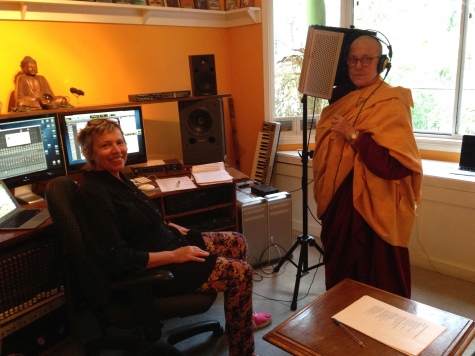
Working with Yantra in her studio on our project, Devotion. And, below, with the Vietnamese children at the Noble Park Buddhist school.
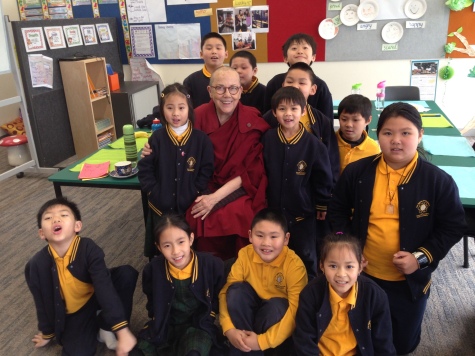
And, as always, I visited Long Bay Prison with Anna Carmody, who goes there twice a week, has for years. I admire her! She’s in for the long haul, and the men totally appreciate that. One of the guards there comes to the classes and now attends the Sydney center, Vajrayana Institute, and has taken Refuge.
In Melbourne Jason Isma, who, with his mother, Rosetta, who lives next door, usually organizes a talk at his home, invited me also to the Vietnamese Buddhist school in Noble Park, where he teaches. They sang me a prayer.
Also in Melbourne, one of our old school mates, Julia, met me and Julie for lunch in Richmond. We three spent some years in the same class, even though they’re 18 months younger than me. At some point at school Julie was put up one class and lazy me was put down. Not a happy situation for my pride, I recall!
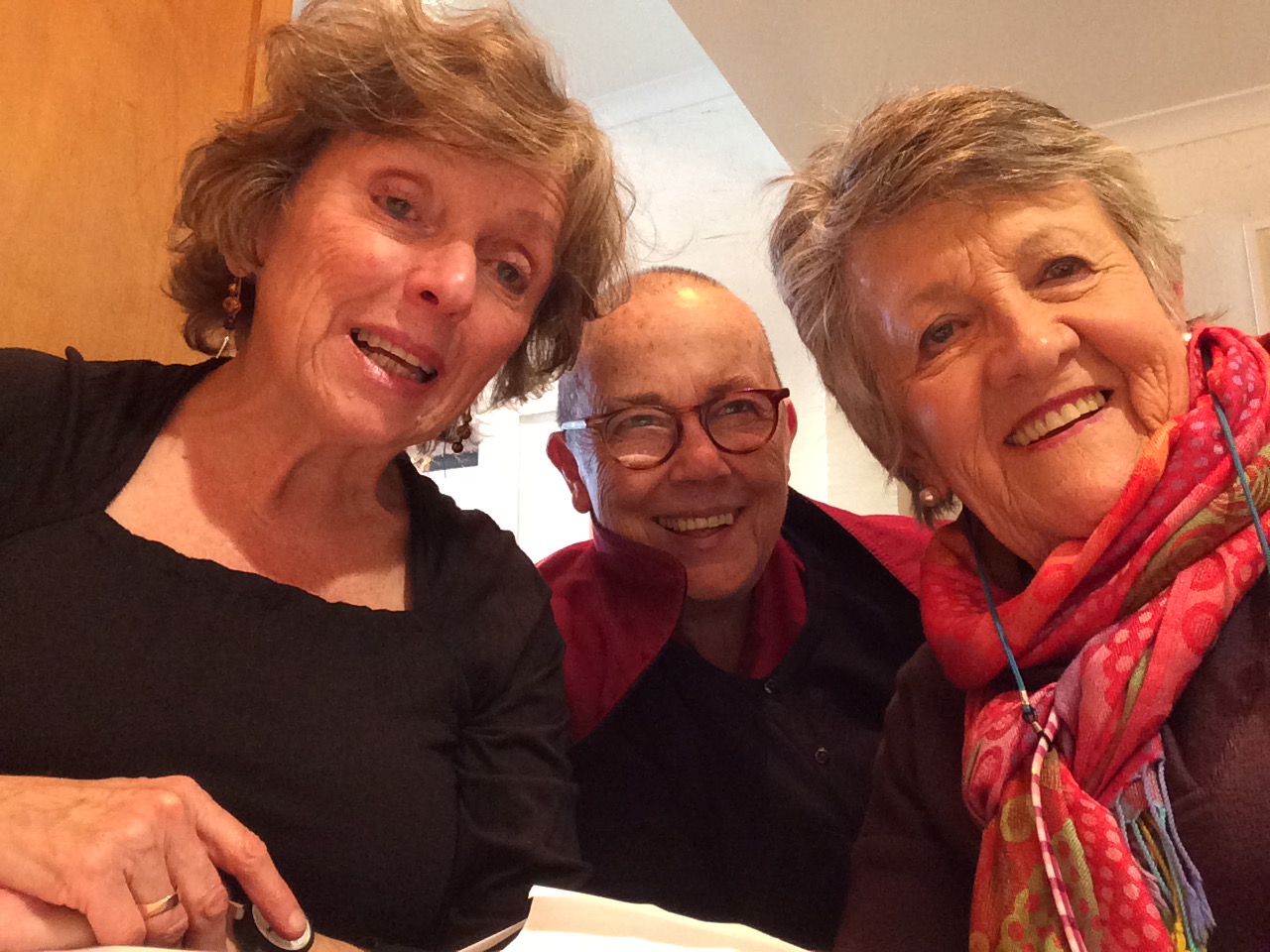
A selfie with sister Julie, left, and old school friend Julia. It’s hard to know where to look in these photos!
And finally, the day before I flew to Kuala Lumpur, August 12, whatever siblings were in town gathered for a meal, as usual, at Julie and Ian’s house in Carlton.

From left: sister Polly, brother Tony’s partner Liz, sister Judy, sister Julie’s husband Ian – who does all the cooking – Julie, and Tony.
--------
Sister Jan in Sydney has written a book: My Lifelong Love Affair with the Swans. Julie did the graphic design, she and her daughter Millie did the website, and I gave some editorial advice. We passed the test of family harmony with flying colors!
Jan’s a fanatic barracker (as they call a sports fan in Australia) of the Sydney Swans Australian Rules football team – it used to be South Melbourne until it was moved north in the 1980s. I never showed the slightest interest in footy (another ridiculous Australianism) – I couldn’t stand the tension, as I mentioned in postcard 41; I’d spend the day with my mother, studying singing. (The CD, Devotion, by the way, is dedicated to her, my music guru.)
But I watch it these day, on my iPad. The Sydney Swans is top of the ladder this year and favorite to win the Grand Final at the end of September. I never watch the matches live, though – again, can’t stand the tension. I watch afterwards, and only if they win. If they lose, I forget about it.
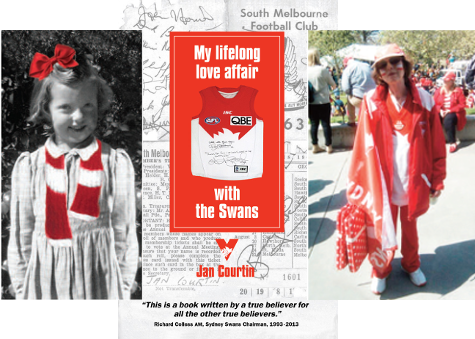
Here’s Jan in her red and white regalia, as a little girl – and as a big girl.
I get a few mentions – here’s one of the photos from the book: in London during our political activist days. I hope she sells many copies! myswansloveaffair.com
